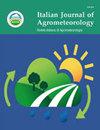Projection of harvestable water from air humidity using artificial neural network (Case study: Chabahar Port)
IF 0.8
4区 农林科学
Q2 AGRONOMY
Italian Journal of Agrometeorology-Rivista Italiana Di Agrometeorologia
Pub Date : 2019-06-03
DOI:10.13128/IJAM-286
引用次数: 4
Abstract
The optimum use of existing water resources as well as the efforts to achieve new water resources have been considered as two major solutions to the relative resolution of water scarcity. Through utilization of the information and meteorological data, it is possible to identify areas with potentials for water harvesting from air humidity. It also allows for collecting and converting them into fresh water using simple physical laws. Due to lack of atmospheric precipitations or inappropriate distribution of precipitations in Chabahar, located in the south of Sistan and Baluchistan province, Iran, water is a limiting factor for agricultural activities and even for the entire life. In this study, water was harvested from air humidity using a screen collector with dimensions of 1×1 m. The magnitude of water harvesting was monitored daily for a period of 365 days. The results revealed that approximately 20% of the water available in the air could be extracted in this area. Then, monthly meteorological data from Chabahar synoptic station between 1990 and 2011 was used to predict the harvestable water for the upcoming year using an artificial neural network. After determining the effective input variables in predicting the amount of harvestable water, the modeling was performed using Multi-Layer Perceptron Network (MLP) and General Feed Forward Network. The results indicated that the MLP network had a higher ability to predict the amount of harvestable water when compared to the GFF network (at the R2 test stage it was 0.86 versus 0.44). The most suitable structure to predict harvestable water from the fog in Chabahar was the MLP Artificial Neural Network with the array of 12-1-25 and the Hyperbolic Tangent Stimulus Function with the Lewenburg Marquette Training Law. Also, the values of the RMSE and MAE error rates were 2.19 and 1.81, respectively. Therefore, it is possible to predict the amount of harvestable water in the next 12 months which can be used in water resources management and productivity.基于人工神经网络的空气湿度可收水量预测(以恰巴哈尔港为例)
最佳利用现有水资源和努力开发新的水资源被认为是相对解决缺水问题的两个主要解决办法。通过利用这些信息和气象数据,可以确定有可能从空气湿度中收集水的地区。它还允许使用简单的物理定律收集并将它们转化为淡水。由于位于伊朗锡斯坦和俾路支省南部的恰巴哈尔缺乏大气降水或降水分布不合理,水是农业活动甚至整个生命的限制因素。在本研究中,利用尺寸为1×1 m的筛网收集器从空气湿度中收集水。每天监测集水量,为期365天。结果表明,该地区可以提取空气中大约20%的水分。然后,利用1990 - 2011年恰巴哈尔气象站的逐月气象数据,利用人工神经网络对来年的可收水量进行预测。在确定预测可采水量的有效输入变量后,使用多层感知网络(MLP)和通用前馈网络进行建模。结果表明,与GFF网络相比,MLP网络具有更高的预测可采水量的能力(在R2检验阶段,它为0.86比0.44)。以121-25为数组的MLP人工神经网络和Lewenburg - Marquette训练律的双曲正切刺激函数是预测恰巴哈尔地区雾中可采水量最合适的结构。RMSE和MAE错误率分别为2.19和1.81。因此,有可能预测未来12个月可用于水资源管理和生产力的可收获水量。
本文章由计算机程序翻译,如有差异,请以英文原文为准。
求助全文
约1分钟内获得全文
求助全文
来源期刊

Italian Journal of Agrometeorology-Rivista Italiana Di Agrometeorologia
AGRONOMY-ENVIRONMENTAL SCIENCES
CiteScore
2.10
自引率
8.30%
发文量
6
期刊介绍:
Among the areas of specific interest of the journal there are: ecophysiology; phenology; plant growth, quality and quantity of production; plant pathology; entomology; welfare conditions of livestocks; soil physics and hydrology; micrometeorology; modeling, simulation and forecasting; remote sensing; territorial planning; geographical information systems and spatialization techniques; instrumentation to measure physical and biological quantities; data validation techniques, agroclimatology; agriculture scientific dissemination; support services for farmers.
 求助内容:
求助内容: 应助结果提醒方式:
应助结果提醒方式:


